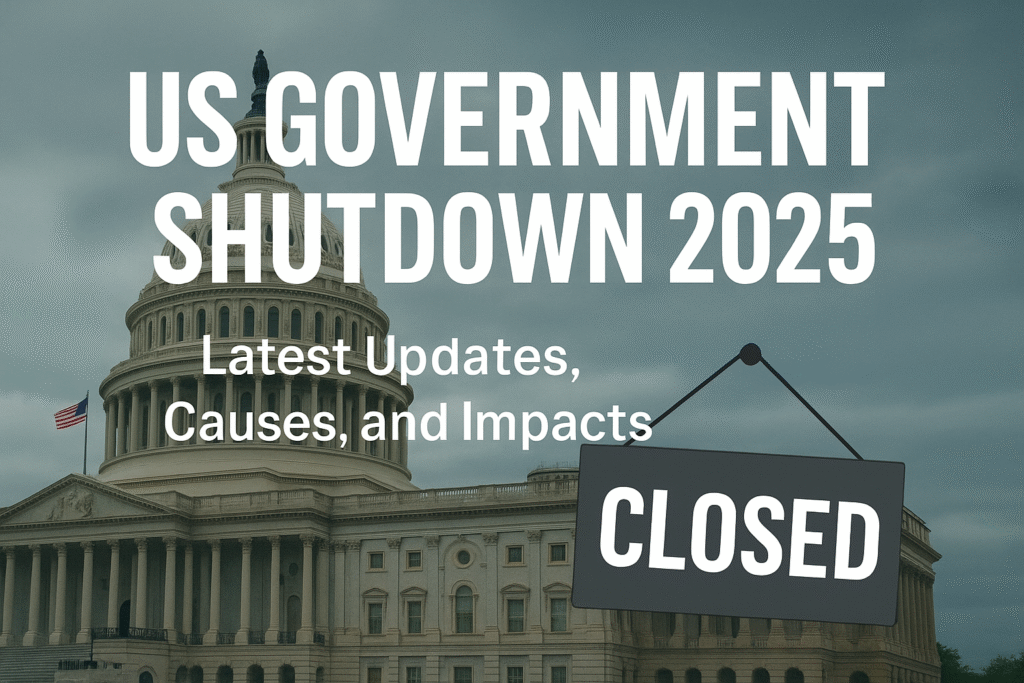US Government Shutdown 2025: A Deepening Political Standoff
The US government shutdown of 2025 continues to grow more intense as lawmakers struggle to reach a funding agreement amid rising political tensions between the White House and Congress. With federal agencies unable to operate, thousands of government employees face uncertainty about their jobs, and essential public services are increasingly strained.
Background: How the Shutdown Began
This shutdown began earlier this month after Congress failed to pass important spending bills to fund federal operations. Disagreements over budget priorities, especially concerning social programs and federal agencies, led to a deadlock between President Donald Trump’s administration and Democratic lawmakers in the Senate.
The White House argues that the spending freeze is necessary to trim wasteful programs and restore financial responsibility. Critics, however, contend that the shutdown has become a political tool aimed at dismantling longstanding Democratic initiatives in social welfare, environmental protection, and public education.
Recently, President Trump stated that his administration will release a list of what he calls “Democrat programs that will not be coming back,” implying that the shutdown may permanently alter the structure of the federal government.
Federal Employees and Public Impact
According to The Guardian, over 4,000 probationary federal employees face potential termination, while hundreds of thousands of others have been furloughed or are working without pay. Essential services like airport security, national parks, and certain healthcare operations are being maintained at minimal levels.
A federal judge in San Francisco has temporarily blocked the administration from firing workers during the shutdown, citing concerns about due process and constitutional protections. This injunction provides short-term relief to federal staff, but legal experts warn it might not hold if the deadlock continues.
Economic analysts estimate that each week of the shutdown costs the U.S. economy billions in lost productivity and consumer confidence. The 2025 closure has already exceeded several previous shutdowns in length, with no clear end in sight.
Political Reactions and Public Response
Republican lawmakers largely support the President’s decision, framing it as a fight against bureaucratic inefficiency. Administration supporters argue that the current situation reflects a necessary reset of federal priorities after years of what they describe as excessive spending by past governments.
In contrast, Democrats accuse the administration of intentionally creating a crisis to push through partisan goals. Senate Minority Leader Chuck Schumer called the move a reckless attack on American workers and families, urging immediate negotiations to restore government functions.
Public opinion remains divided. A recent poll by Reuters/Ipsos found that 47% of Americans blame the Trump administration for the shutdown, while 39% hold congressional Democrats responsible. The remaining 14% believe both sides share responsibility for the ongoing stalemate.
Market and Economic Implications
Initially, Wall Street showed signs of worry, but markets have slightly recovered after Federal Reserve Chair Jerome Powell hinted at a possible rate cut before the year ends. Analysts believe the Fed’s position is helping to soften the economic impact of the shutdown, though prolonged instability could reverse these gains.
Businesses that rely on federal contracts are already feeling the effects. Contractors providing goods and services to government departments have reported delays in payments and uncertainty about future work. Small businesses located near federal offices also report reduced foot traffic and sales.
International Reactions
The U.S. shutdown has caught global attention, with international observers warning of broader economic consequences. Trade partners, especially in Europe and Asia, are closely watching developments because the political paralysis in Washington could affect ongoing negotiations on tariffs and trade policies.
China’s state media has criticized the shutdown as evidence of dysfunction in the American political system, while European leaders have expressed concern about the reliability of U.S. commitments abroad during this internal crisis.
Prospects for Resolution
Despite mounting pressure, negotiations remain stalled. Congressional leaders have held multiple rounds of discussions, but both sides are still entrenched. President Trump insists he will not sign any spending bill that funds what he describes as wasteful Democratic programs, while Democrats refuse to accept cuts they believe would harm millions of Americans.
Some moderate lawmakers from both parties propose temporary funding measures to reopen essential services while broader negotiations continue. However, these proposals have so far failed to gain support in either chamber.
Political analysts predict that a resolution may ultimately rely on public pressure as the social and economic impact of the shutdown becomes more apparent. If the deadlock continues, it could become one of the longest and most significant government shutdowns in U.S. history.
Conclusion
The US government shutdown of 2025 highlights the widening divide in American politics. What started as a budget disagreement has turned into a symbolic struggle over the future direction of the federal government.
As federal workers await clarity and markets cautiously adjust to uncertainty, the shutdown underscores both the fragility and resilience of the American political system. Whether compromise or confrontation prevails will determine not only how soon the government reopens but also how the nation defines governance in the coming years.



